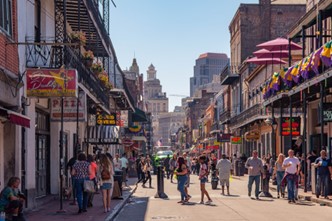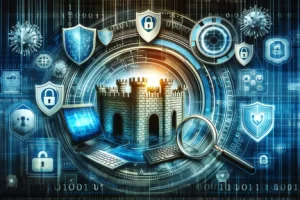Rapid growth of Internet and dependency of many businesses, colleges as well as the government sector and new services such as online banking, e-commerce, VoIP, etc. to the Internet, are the main reason of demand for Internet access. It is almost a decade that broadband Internet has provided the high speed Internet access to the users. However, this does not fulfill the market requirement for mobility and portability. People are interested in having high-speed Internet access everywhere and at anytime available at their fingertips.
The growth of wireless network and Wi-Fi technology, a substitute to the expensive and not very realistic fiber optic solution for homes and businesses, which was providing high-speed Internet access over Wi-Fi network, is becoming more and more popular throughout the United States. Many businesses implemented Wi-Fi technology and internet as part of their marketing strategy to attract customers. Good examples for these business are McDonald’s, Starbucks, and many other food places, offering wireless internet access to their customers for free or a small fee. Such a model attracts many business executives to take advantage of these services and relocating their offices to new places. Besides businesses, many cites are looking at the idea of providing citywide wireless internet for their citizens. The idea, ‘citywide Wi-Fi mesh network’, is offering many advantages over other wired solutions but it also comes with disadvantages that cities will have to face when offering these services.
Advantages of Citywide Wi-Fi
This paper evaluates if cities, and especially in this case the City of New Orleans should establish a city wide wireless internet and what advantages it will bring for the city, its citizen and what impact it might have on the local economy. During this analysis the various impacts citywide Wi-Fi will have on New Orleans will be examined and it will be proven that if basic technology that will support Wi-Fi is already in place, it can be very useful for New Orleans, especially after the impact of Hurricane Katrina, to re-establish its infrastructure, attract businesses and business opportunities, provide better and faster assistance for their citizens trying to deal with government agencies and solving post-Katrina issues. But the paper will also show that if the basic technological infrastructure is not in place, the Wi-Fi project will not be as successful and trying to establish the basic, will take up a lot of resources – manpower as well as finances – which can be used for more imminent needs in New Orleans.
In last few years, many cities have started or planned to implement the Wi-Fi network in their cities. Grand Haven in Michigan was the first city in the world that successfully completed its Wi-Fi City project in July 2004. Taipei as the first large and modern city has started its Wi-Fi City project in 2004, and subsequently many other cities such as
Philadelphia, San Francisco, Toronto, etc. have followed the same idea. One of the big challenges in implementing such a network was developing a business model. At a time that Taipei has started its project, there was no working model at such scale around the world that can be used as a prototype. Therefore, Taipei and other cities have made their own business model based on their requirements and New Orleans will have to follow their steps by creating their own business model based on their unique situation and needs after hurricane Katrina (Weisman, 2006).
Plan for the Future
Obviously, there is one main reason why the government and city of New Orleans will support the Wi-Fi implementation as one of the main priorities in their city. Using such a network assists cities to decrease lots of their costs by replacing the wired T1 Internet connections with its equivalent wireless connection and using VoWiFi technology to decrease their telephone costs. Considering the fact that most of New Orleans communication infrastructure – especially the communication infrastructure based on cable has been destroyed and was not functional, it is not only a financial reason to replace it but also a practical as well as a futuristic argument. The costs and man-power needed to repair and establish the old system might be not as high as creating a new Wi-Fi system, but the old cable based communication system would not be as efficient in the long-run as a new implemented Wi-Fi system that could be used more efficiently, cheaper and be easily upgradeable in the long run to meet the cities needs in the next decades (Weisman, 2006).
Implementing and having an ubiquitous network and seamless connection to the Internet, fast design and implementation along with very low cost, portability and mobility, ease of upgrade and expansion and many more features that can be used in the near and far future are the main reasons why New Orleans should implement a Wi-Fi solution instead of repairing the past wired network which is not only considered expensive but also somewhat older technology that cannot be easily implemented to all areas of the city, its citizens and municipal agencies with a cost effective solution and still not providing the required and needed mobility.
Emergency Management Solution
Another main argument for implementing Wi-Fi in New Orleans is the current Emergency situation after Hurricane Katrina and all efforts from the city, people and the government to return the city to its old shape. For that it is essential that police and emergency rescuers as well as any other government and municipal agencies have access to real-time feeds from security cameras as well as police officers having the option to monitor the situation and access blueprints of the building, including its entrances, exits and hiding places from their patrol car. First responders need video, Geographical Information Systems (GIS), high-resolution still images, and other broadband data wherever their work takes them and on highways, high-resolution images must be delivered as soon as possible. Further, first responders need broadband data delivered deep inside buildings on portable handheld devices, just as voice signals are now delivered by our new voice network. Adequate response to emergencies ranging from multiple-alarm building fires to chemical, biological and other terrorist attacks requires immediate and rapid communications among multiple first-responders including fire, police, and emergency medical services. Part of the New Orleans city network will be secured so that it can be used exclusively by the city to provide communications for municipal agencies like police, fire, and building inspection departments. The additional bandwidth on the network will be opened to the public to provide free Internet access to all citizens (Reardon, 2005).
Currently, first-responders must rely on voice communications to receive time-sensitive information about an emergency incident. Information often comes too late or is lost altogether. Broadband wireless networks can dramatically improve public safety communications and operations nationally by providing full- motion, high-resolution video and other bandwidth-intensive monitoring tools to multiple first responders. These tools will allow sharing of time-critical information needed to respond more effectively to both routine and catastrophic events (Legrande, 2004).
Other Government Benefits
Besides emergency responses that can take a great advantage of city-wide Wi-Fi, the city itself and the municipal government agencies will benefit a lot from it just as will the citizens. Among the five areas of “Information Super Highway” which is highly recognized in every country, ‘E- government” is the number one priority. It is obvious that government information on-line is the foundation of information society. The so-called “E-government” is the electronically network the functions of the government, to build a virtual government on-line in order to fulfill the function of the government. Once it is on-line, the government can publish information, organizational system and other paper-works to the public. The government tries to publish as much as possible on-line in order to build the communicational bridge between the government and the public for convenience. This is very important, especially in a situation that New Orleans faces, when businesses and citizens as well as emergency response teams will need access to government information, forms and documents or need to submit new building or zoning permits. The needed information will be easily available to all via website and city-wide Wi-Fi, which again, will minimize the customer contact at the municipal offices and that again will result in faster document processing, because government employees will be able to focus on more important task than spending time answering customer questions or handing out necessary forms and documents. Also, the public can audit the government’s activity on-line. After the government has provided on-line services, the efficiency of the government is highly increased, the manpower of the government is saved, the system is simplified and the expense is cut (Wilson, 2003).
In addition to providing fast response possibilities to the city and the government agencies via wireless network, the cities have other goals as well. They want to improve worker productivity, make the city more attractive to businesses, bolster the economy, bridge the digital divide or do all these things with one network. Citywide Wi-Fi or Wi-Fi City has opened many new opportunities for the cities. Providing a better Internet infrastructure throughout the city by making a blanket of Wi-Fi Mesh network and giving broadband Internet access to everyone in the city, alluring more tourists to visit the city, attracting new investors to start their business in those cities that are taking advantage from Wi-Fi network, bringing more security to the city by installing wireless camera in most of the places, potential interoperability with other businesses such as mobile operators, WiMAX networks, etc. are just part of many opportunities that is brought by this solution (Wilson, 2003).
Citywide Wi-Fi Deployment
The number of Citywide Wi-Fi deployment at urban centers is on the rise both in the US and other parts of the world. As well, Citywide Wi-Fi, in many instances, provides to its subscribers access to the Internet for free, or at a minimal cost. Consequently, often upon the availability of Citywide Wi-Fi in an area, residents and small businesses consider both the cost savings and practicalities of replacing their existing wired broadband Internet service with Citywide Wi-Fi. While households and businesses utilizing only basic wired broadband Internet service can simply switch and take advantage of the cost savings, households and businesses that subscribe to premium service features – such as web and email hosting, domain name service, etc. – are often required to retain wired broadband Internet service. For such households and businesses, in spite of the need to retain wired broadband, Citywide Wi-Fi can still bring forth value when the bandwidth is combined with wired broadband to enhance Internet service performance and increase availability. As citywide wireless networks proliferate, service providers and network operators are quickly realizing that wireless subscriber stations – small devices that enhance communication between customers’ computers and Citywide Wi-Fi networks – will play a central role to successful service deployment. This is great news for residents, businesses and visitors in St. Petersburg,” said Mayor Rick Baker. “Soon, all Internet users in our city will have the opportunity to obtain seamless, reliable and affordable wireless broadband access that will help us promote job creation, business and economic growth, and enhance the quality of life of residents and visitors to the city.”
Advantages and Disadvantages
But just as with anything where there are advantages, there are disadvantages and in this case the disadvantages might outrun the advantages. During Hurricane Katrina, New Orleans’ infrastructure was destroyed, leaving almost all communication technology non functional or destroyed. Although after such an impact, it is highly recommended to built a newer infrastructure that will allow more flexibility and easy configuration changes in the future, the manpower and financial costs need to be considered. Is the old infrastructure in such a desolate shape that it will cost more to rebuilt it or can it be easily repaired and used to provide emergency response teams with the basic but required tools to get their work done as soon as possible? If that is the case, it might be a good solution to focus on the emergency needs first rather than building a Wi-Fi solution. The city will have to analyze the exact costs and manpower as well as the current emergencies that exist and make a decision if the implementation of Wi-Fi will overall improve the reconstruction efforts or if priorities are within the current and existing emergencies such saving people, evaluating damage, cleanup and reconstruction. If the current emergency situation is not as urgent and the arguments for a city-wide Wi-Fi prevail, the implementation should be started because in the long run it will provide the city with more advantages such as attracting citizens, creating jobs as well as attracting tourism, which again will boost the economy. But also a Citywide Wi-Fi will allow will bridge the digital divide so that even the city’s poorest residents have affordable access to high-speed Internet connections and therefore supporting the personal and education growth of its citizens, creating a safe working and living environment throughout the city as well as providing its citizen government and municipal services to improve their current situation just a mouse-click away.
![]()
![]()





